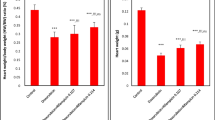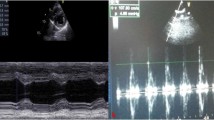Summary
The protective activity of the bisdioxopiperazine ICRF-187 against the cardiotoxicity of doxorubicin was evaluated in the rat using both functional and histological assays. Animals that had received a single i. v. dose of doxorubicin (4 mg/kg) alone were compared with those that had been pretreated with a single i. v. injection of saline or ICRF-187 (40 or 60 mg/kg). All rats showed a transient reduction in body weight during the first 3 weeks after drug administration. The greatest reduction (∼16%) was observed in animals that had received a combination of ICRF-187 (40 or 60 mg/kg) and doxorubicin. Deaths related to cardiotoxicity were observed only in rats that had received doxorubicin alone and in those treated with saline; most of the deaths occurred at between 8 and 13 weeks after drug administration. Sequential assessments of heart function showed a persistent depression of cardiac output in animals that had received doxorubicin, with or without pretreatment with ICRF-187. The reduction in cardiac output observed in rats that had been pretreated with ICRF-187 (40 or 60 mg/kg) amounted to ∼15% and ∼30% after 12 and 20 weeks, respectively, indicating that cardioprotection was only partial. Nevertheless, this represented a marked improvement as compared with the ∼35% reduction in cardiac output measured at 12 weeks in animals that had received doxorubicin but without pretreatment with ICRF-187. Histological examination of animals that had died during the course of the study and had received doxorubicin after pretreatment with saline revealed severe myocardial lesions typical of doxorubicin-induced damage. In contrast, animals that had been pretreated with ICRF-187 and survived for up to 20 weeks after treatment showed a marked amelioration of these lesions. The present findings may be interpreted as a true cardioprotection or a delay in the onset of the cardiotoxicity of doxorubicin resulting from pretreatment with the bisdioxopiperazine ICRF-187. Although prior and ongoing clinical trials clearly indicate that ICRF-187 protects patients well against doxorubicin-induced heart damage, further investigations are required beforehigh doses of ICRF-187 can be used as a means of increasing the protective activity of this drug against doxorubicin-induced cardiotoxicity.
Similar content being viewed by others
References
Blum RH (1975) An overview of studies with Adriamycin in the United States. Cancer Chemother Rep 6: 247
Dawson KM (1975) Studies on the stability and cellular distribution of dioxopiperazines in cultured BHK-21 cells. Biochem Pharmacol 24: 2245
Doroshow JH (1988) Role of reactive oxygen production in doxorubicin cardiac toxicity. In: Hacker MP, Lazo JS, Tritton TR (eds) Organ directed toxicities of anticancer drugs. Martinus Nijhoff, Boston, p 31
Eliot H, Gianni L, Myers CE (1984) Oxidative destruction of DNA by Adriamycin-iron complex. Biochemistry 23: 928
Filppi JA, Imondi AR, Wolgemuth RL (1988) Characterization of the cardioprotective effect of (S) (+)-4,4′-propylene-2,6-piperazinedione (ICRF-187) on anthracycline cardiotoxicity. In: Hacker MP, Lazo JS, Tritton TR (eds) Organ directed toxicities of anticancer drugs. Martinus Nijhoff, Boston, p 225
Green MD (1987) Rationale and strategy for prevention of anthracycline cardiotoxicity with the bisdioxopiperazine, ICRF-187. Pathol Biol 35: 49
Gutteridge JMC (1983) Adriamycin-iron catalysed phospholipid peroxidation: a reaction not involving Adriamycin or hydroxyl radicals. Biochem Pharmacol 32: 1945
Herman EH, Ferrans VJ (1983) ICRF-187 reduction of chronic daunomycin and doxorubicin cardiac toxicity in rabbits, beagle dogs and miniature pigs. Drug Exp Clin Res 9: 483
Herman EH, Ferrans VJ (1983) Influence of vitamin E and ICRF-187 on chronic doxorubicin cardiotoxicity in miniature swine. Lab Invest 49: 69
Herman EH, Ferrans VJ (1990) Examination of the potential longlasting protective effect of ICRF-187 against anthracycline-induced chronic cardiomyopathy. Cancer Treat Rev 17: 155
Herman EH, Ferrans VJ, Myers CE, Vleet JF van (1985) Comparison of the effectiveness of (±)-1,2-bis(3,5-dioxopiperazin-1-yl)propane (ICRF-187) andN-acetylcysteine in preventing chronic doxorubicin cardiotoxicity in beagles. Cancer Res 45: 276
Hortobagyi GN, Frye D, Buzdar AU, Ewer MS, Fraschini G, Huo V, Ames F, Montague E, Carrasco CH, Mackay B, Benjamin RS (1989) Decreased cardiac toxicity of doxorubicin administered by continuous intravenous infusion in combination chemotherapy for metastatic breast carcinoma. Cancer 63: 37
Huang ZX, May PM, Quinlan KM, Williams DR, Creighton AM (1982) Metal binding by pharmaceuticals: 2. Interactions of Ca(II), Cu(II), Fe(II), Mg(II), Mn(II) and Zn(II) with the intracellular hydrolysis products of the antitumour agent ICRF-159 and its inactive homologue ICRF-192. Agents Actions 12: 536
Jaenke RS (1976) Delayed and progressive myocardial lesions after Adriamycin administration in the rabbit. Cancer Res 36: 2958
Jaenke RS, Fajardo LF (1977) Adriamycin-induced myocardial lesions. Am J Surg Pathol 1: 55
Jensen RA (1986) Doxorubicin cardiotoxicity: contractile changes after long term treatment in the rat. J Pharmacol Exp Ther 236: 197
Milei J, Boveris A, Llesuy S, Molina HS, Storino R, Ortesa D, Milei SE (1986) Amelioration of Adriamycin-induced cardiotoxicity in rabbits by prenylamine and vitamins A and E. Am Heart J 111: 95
Myers CE (1988) Role for iron in anthracycline action. In: Hacker MP, Lazo JS, Tritton TR (eds) Organ directed toxicities of anticancer drugs. Martinus Nijhoff, Boston, p 17
Myers CE, Gianni L, Simone CB, Klecker R, Greene R (1982) Oxidative destruction of erythrocyte ghost membranes catalyzed by the doxorubicin-iron complex. Biochemistry 21: 1707
Neri B, Cini-Neri G, Bandinelli M, Bartalucci S, Cialpio A (1989) Doxorubicin and epirubicin cardiotoxicity: experimental and clinical aspects. Int J Clin Pharmacol Ther Toxicol 27: 217
Olson RD, Mushlin PS (1990) Doxorubicin cardiotoxicity: analysis of prevailing hypotheses. FASEB J 4: 3076
Rabkin SW (1983) Interaction of external calcium concentration and verapamil on the effects of doxorubicin (Adriamycin) in the isolated heart preparation. J Cardiovasc Pharmacol 5: 848
Rahman A, Schein PS (1988) Use of liposomes in cancer chemotherapy. In: Gregoriadis G (ed) Liposomes as drug carriers John Wiley & Sons, Chichester, p 381
Shapira J, Gotfried M, Lishner M, Ravid M (1990) Reduced cardiotoxicity of doxorubicin by a 6-hour infusion regimen. Cancer 65: 870
Speyer JL, Green MD, Kramer E, Rey M, Sanger J, Ward C, Dubin N, Freeans V, Stecy P, Zeleniuch-Jacquotte A, Wernz J, Feit F, Slater W, Blum R, Muggia F (1988) Protective effect of the bispiperazinedione ICRF-187 against doxorubicin-induced cardiac toxicity in women with advanced breast cancer. N Engl J Med 319: 745
Villani F, Galimberti M, Monti E, Cova D, Lanza E, Rozza-Dionigi A, Favalli L, Poggi P (1990) Effect of ICRF-187 pretreatment against doxorubicin-induced delayed cardiotoxicity in the rat. Toxicol Appl Pharmacol 102: 292
Von Hoff DD, Howser D, Lewis BJ, Holcenberg J, Weiss RB, Young RC (1981) Phase I study of ICRF-187 using a daily for 3 days schedule. Cancer Treat Rep 65: 249
Weiss RB, Sarosy G, Clagett-Carr K, Russo M, Leyland-Jones B (1986) Anthracycline analogs: the past, present and future. Cancer Chemother Pharmacol 18: 185
Yamanaka N, Kato T, Nishida K, Fujikawa T, Fukushima M, Ota K (1979) Elevation of serum lipid peroxide levels associated with doxorubicin toxicity and its amelioration by [d, l]-α-tocopheryl acetate or coenzyme Q10 in mouse. Cancer Chemother Pharmacol 3: 223
Yeung TK, Simmonds RH, Hopewell JW (1988) Time- and dose-related modifications in cardiac function in rats after single intravenous doses of epirubicin. Radiother Oncol 11: 263
Yeung TK, Simmonds RH, Hopewell JW (1989) A functional assessment of the relative cardiotoxicity of Adriamycin and epirubicin in the rat. Radiother Oncol 15: 275
Yeung TK, Simmonds RH, Hopewell JW (1989) The relative toxicity of intravenous and intraperitoneal doses of epirubicin in the rat. Cancer Chemother Pharmacol 24: 211
Yeung TK, Hopewell JW, Simmonds RH, Seymour LW, Duncan R, Bellini D, Grandi M, Spreafico F, Strohalm J, Ulbrich K (1991) Reduced cardiotoxicity of doxorubicin administered in the form ofN-(2-hydroxypropyl)methacrylamide conjugates: an experimental study in the rat. Cancer Chemother Pharmacol 29: 105
Author information
Authors and Affiliations
Additional information
This work was supported by the Cancer Research Campaign
Rights and permissions
About this article
Cite this article
Yeung, T.K., Jaenke, R.S., Wilding, D. et al. The protective activity of ICRF-187 against doxorubicin-induced cardiotoxicity in the rat. Cancer Chemother. Pharmacol. 30, 58–64 (1992). https://doi.org/10.1007/BF00686486
Received:
Accepted:
Issue Date:
DOI: https://doi.org/10.1007/BF00686486




